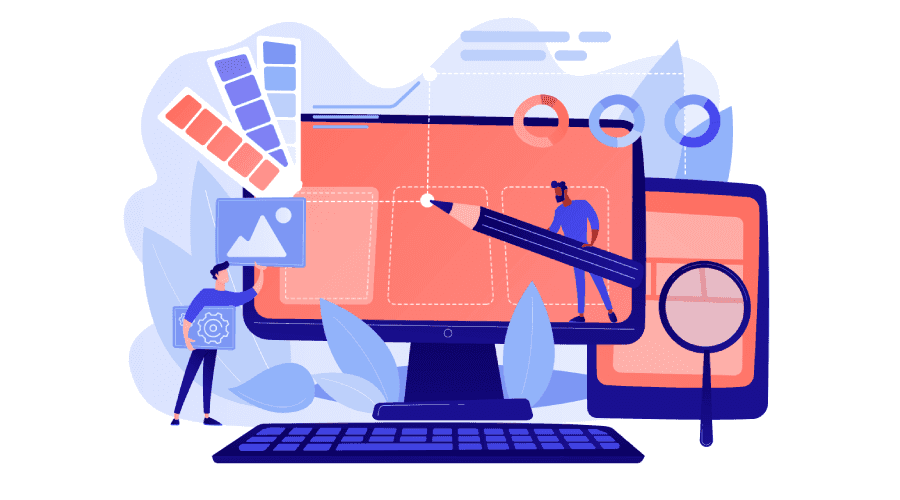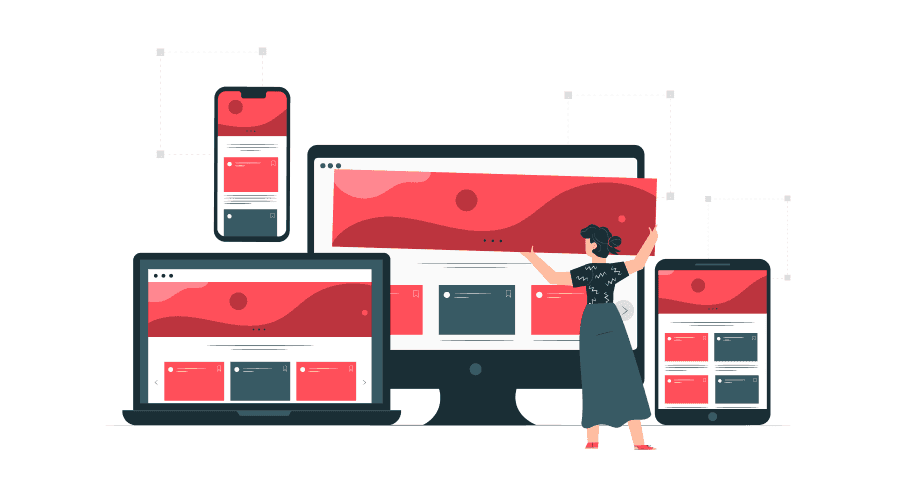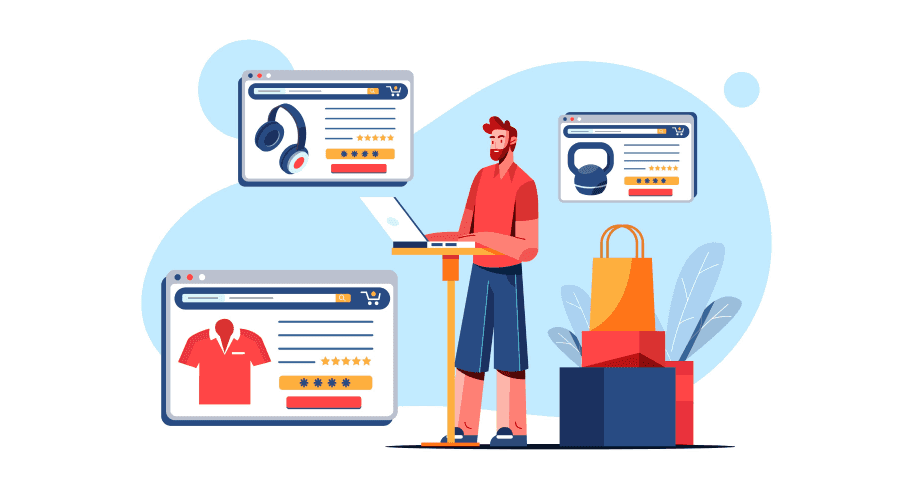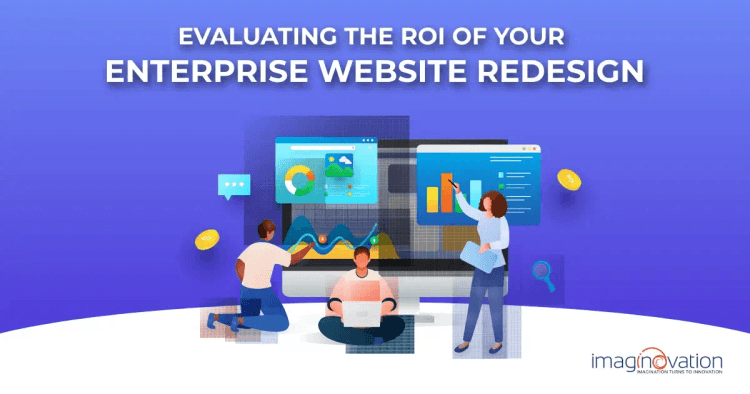If you haven't updated your website in a while, consider doing it now.
However, the decision to invest in a website redesign is not one to be taken lightly.
Is the cost worth the value it will bring to your company? How do you determine the return on investment (ROI) of such a project? Does your enterprise website design really need to be revamped?
This blog post answers these critical questions.
Moreover, since deciding to redesign an enterprise website involves analyzing costs and benefits, we will also discuss the factors to consider when analyzing the cost versus the value.
Let's go!
Importance of a Well-designed Enterprise Website
A well-designed enterprise website can make a world of difference for your business.
A well-designed website showcases your brand in the best possible light and attracts and engages potential customers.
It's like having a digital storefront that's open 24/7, ready to impress and convert visitors into loyal customers.
Let's find out why investing in a top-notch website matters.
1. Establishes the first impression
A user forms an opinion about your business within moments of landing on your website. Ensure your enterprise website design leaves visitors with a positive and lasting impression. A well-designed site showcases credibility and influences how people perceive your business. This impression can either retain visitors or send them to a competitor.
2. Builds an excellent customer service impression
Your web design is like your business's face. A friendly face welcomes people in person, and an updated web design does the same for online visitors. Neglecting your website sends a message that you won't put effort into helping customers. A well-designed enterprise website, on the other hand, shows care for your audience and good customer service.
3. Helps in Search Engine Optimization (SEO)
A well-designed website is optimized for search engines. Following best practices for enterprise web design and structure can improve your SEO performance, making it easier for search engines to index your site. This, in turn, leads to higher rankings, increased visibility, and more organic traffic.
4. Maintains consistency
Consistency in enterprise website design is crucial for building a solid brand and attracting new leads. When your website has the same fonts, styles, and layouts across every page, it creates a professional and recognizable image. Inconsistency breeds distrust and drives visitors away. Building consistency is essential for keeping leads engaged and ultimately driving more conversions.
5. Helps in user retention
The impact of a good web design on user retention is undeniable. A Google study revealed that 79% of users would not return to a website they didn't like, while an Adobe study found that 59% of users prefer beautifully designed websites. Users have high expectations regarding enterprise web design; if a website fails to meet those expectations, they will leave.
6. Creates seamless user experience
A well-crafted website provides a good user experience (UX). A seamless UX refers to the overall satisfaction and ease of use visitors experience when interacting with the site. This boosts engagement and conversion rates.
7. Builds a competitive advantage
In today's highly competitive business landscape, a well-designed website sets you apart from competitors. It demonstrates that you are up-to-date, technologically advanced, and invested in providing the best online experience for your customers.
8. Enhances credibility and trust
A professionally designed website instills trust and confidence in your brand. When potential customers perceive your website as visually appealing, easy to use, and secure, it enhances their confidence in your business, making them more likely to choose your products or services.
Understanding the Cost of Website Redesign
Upgrading a website is crucial for businesses to remain relevant and competitive.
However, it's essential to understand the costs involved in a redesign project. It helps you ensure it's an investment worth making.
Let us begin by exploring the various factors that impact the cost of website redesign.
1. Size and complexity of the website

Website size and complexity heavily influence redesign costs.
Larger websites with more pages, features, and functionality will require more time and effort to redesign. They'll also need more changes and revisions, which can impact the project's total cost.
Complex websites that involve intricate designs, interactive elements, or custom functionalities may also require more specialized skills, which can impact the overall cost.
So, to determine an accurate quote for your website redesign, check how many pages you are planning for your website, what will be their size, and how complex they are.
2. Content creation and migration
Content plays a critical role in an enterprise website redesign.
If you already have well-structured and ready-to-use content, it can reduce the overall cost.
However, if content needs to be created from scratch or migrated from an old website to a new design, it will require additional time and resources, potentially increasing the cost.
Check if you already have the content for each page or need to create it or hire someone to do it. The answer to this will undoubtedly impact the cost of your website redesign.
3. Enhanced functionality
Do you plan to add new functionalities or integrate third-party systems into your redesigned website?
These may include e-commerce capabilities, customer portals, or API integrations.
It matters because these enhancements may require additional development work, integration efforts, and potential licensing fees or subscriptions, thus increasing the cost of website redesign.
It is crucial to weigh the benefits and costs of enhanced functionality during the website redesign process, ensuring that the added functionalities align with your business goals and provide value to your users or customers.
4. Technology and platform
The technology stack and content management system (CMS) you chose for the enterprise web design can also influence the cost.
Some platforms or CMS options may have higher licensing or development costs, while others may be more cost-effective or offer flexibility in terms of customization.
Besides, accurately assessing functionality requires knowledge of the specific platform used for the website redesign.
5. Type of design and customization requirements
Design and customization requirements affect website redesign costs.
If you require a unique and highly customized design with custom graphics, animations, or interactive elements, it may require more time and expertise from designers and developers.
The complexity of the requested design and the number of revisions also affect the website revamp cost.
6. Timeline and urgency

The timeline and urgency of the project can increase the cost of website redesign due to several reasons.
Firstly, when there is a tight timeline or urgent project deadline, it may require additional resources to allocate to the project.
Secondly, the urgency of a website redesign often leads to a more compressed and accelerated workflow, which can increase the cost.
The development team may need to expedite tasks, resulting in less time for in-depth planning, design iterations, and comprehensive testing. Rushing these processes can lead to errors, requiring additional time and resources to fix.
It is important to note that each website redesign project is unique, and the impact of various factors on cost can vary depending on the specific circumstances.
Hidden Costs of Website Redesign
When considering the cost of a website redesign, please be aware of some potential hidden costs that can significantly impact your budget. Here are some hidden costs to consider.
1. Including graphic design and visual assets
When you decide you need to revamp your enterprise website design, you may want to update the visual elements such as graphics, images, icons, graphs, and visual branding.
It may result in additional costs if you need custom-designed visual assets or the design team needs to source and purchase stock images.
It's important to factor in this expense when planning your project budget.
2. Maintenance, updates, and ongoing support
It's essential to keep in mind that ongoing maintenance and updates are necessary even after your website redesign is complete.
Regular software updates, security patches, and maintenance tasks are crucial in keeping your website secure, running smoothly, and compatible with the latest web technologies.
However, it's worth noting that these activities come with additional costs.
To avoid unexpected expenses down the line, be sure to budget for these ongoing tasks.
3. Training and employee onboarding.
Training employees on the new website's features and functionality can consume valuable time and resources.
This includes preparing training materials, conducting training sessions, and providing necessary support during onboarding.
Moreover, organizations may sometimes need to hire consultants to facilitate the training and onboarding process. This incurs additional costs for their expertise or training resources.
4. SEO optimization.
Website redesigns are a perfect opportunity to optimize your web content for search engines.
Optimizing your website with SEO best practices boosts online audience growth and business success.
However, this requires investing in SEO (Search Engine Optimization) activities such as keyword research, on-page optimization, URL redirects, and more.
Assessing the Value of Website Redesign
A makeover can breathe new life into your enterprise website, improve user experience, and boost conversions.
However, it can be a big undertaking, and we may wonder if it's worth the cost, time, and effort.
Let's find out what factors help you accurately assess the value of an enterprise web design or redesign and let you confidently decide what is best for your business goals.
Enhanced user experience and engagement.
If you want to ensure a good user experience for your website, it is crucial to focus on enabling your visitors to accomplish their goals.
This begins with understanding their needs and incorporating this knowledge into your user experience strategy.
To enhance user experience and engagement, prioritize improving site navigation, responsive design for mobile users, and page load speed.
Make sure to address any pain points your users may have. By considering these factors and their positive impact, you can better evaluate the value of a website redesign.
Let's delve into how you can do this.
1. Site Navigation
A seamless site navigation means visitors should be able to easily find the information they need and navigate through different sections of the website. You can achieve it by using -
- Clear and organized menu structure.
- Intuitive labeling without technical jargon or ambiguous terms.
- An efficient search feature that enables quick access to specific information.
- Breadcrumbs to give users a clear understanding of their current location within the website.
2. Responsive Design for Mobile Users

With the increasing use of mobile devices, it is crucial to prioritize responsive design to accommodate users accessing your website on various screen sizes. A responsive design ensures that your website provides mobile users with a consistent experience. Here's how you can do it.
- Design your website with a mobile-first approach, considering the smaller screen size and touch-based interactions.
- Optimize images and media to load quickly on mobile devices without losing quality.
- Design buttons, menus, and other interactive elements to be easily tappable.
3. Page Load Speed
Page load speed also plays a crucial role in user experience and engagement. Slow-loading pages can lead to frustration and increased bounce rates. To improve page load speed and retain visitors, consider the following:
- Image optimization - Compress and resize images without significant loss in quality.
- Minify CSS, HTML, and JavaScript files to reduce their size and improve load time.
- Implement browser caching to store static resources.
- Select fast and reliable web hosting for website accessibility and quick loading.
4. Incorporate interactive features & multimedia.
Incorporating interactive features and multimedia into your website can significantly enhance user experience and engagement. These elements can add personality and interactivity to your website, making it more engaging and memorable for users. Here’s what you need to do.
- Add small interactive elements like hover effects, animations, and sound effects to add delight to your website.
- Include videos and audio files on your website that provide users a more immersive and engaging experience.
- Infographics and data visualization simplify complex information, making it more engaging and memorable for users. For example, a financial website can display interactive graphs showing stock market trends.
- Add gamification elements, such as rewards, badges, and competitions, that can make the user experience more engaging and interactive.
Increased lead generation and conversion rates.
One key factor in assessing a website redesign's value is its impact on lead generation and conversion rates.
A website is a powerful tool for generating leads and converting them into customers. Here's what you should do:
1. Optimize landing pages
Landing pages are key for capturing leads and driving conversions. By optimizing landing pages, businesses can enhance user experience and encourage visitors to take action. Include the following elements -
- Use clear headlines to grab attention and communicate value.
- Keep content concise and persuasive, highlighting benefits and unique selling points.
- Place well-designed and prominent call-to-action buttons.
- Incorporate testimonials and social proof to gain trust.
2. Include Call-to-Action Buttons
Call-to-action buttons are potent tools for driving conversions. They can guide visitors toward the desired action when strategically placed and designed.
- Position CTAs prominently on web pages.
- Design CTAs to stand out with contrasting colors and compelling copy.
- Use persuasive language to communicate the desired action and its value.
3. Streamline Checkout Process for E-commerce Websites

For e-commerce websites, streamlining the checkout process is critical for minimizing cart abandonment rates and boosting conversion rates.
- Simplify steps and minimize form fields.
- Offer a guest checkout option for convenience.
- Display trust symbols and security badges to ensure a secure payment process.
4. Integrate with Customer Relationship Management (CRM) Systems
Integrating your website with a CRM system allows for seamless management of leads and the nurturing process. This integration provides several benefits
- Automatically capture leads within the CRM system.
- Use CRM data for personalized email campaigns and automated follow-ups.
Also Read: App Redesign: When and How to Start it? Explained with Examples
Calculating the ROI of Enterprise Website Redesign
ROI stands for Return on Investment, which is a measure of the profitability or effectiveness of an investment relative to its cost. In simple terms, the ROI of enterprise website design tells us whether the investment was worth the money and effort put into it.
It is essential for enterprise website design because businesses want to ensure that the time, resources, and money invested in the redesign result in positive outcomes.
If a website redesign generates a high return on investment, it means that the redesign successfully achieved its goals, such as increasing leads, conversions, or revenue.
Here are the key metrics for measuring the success of a website redesign:
1. Conversion Rate
This metric keeps track of the percentage of website visitors who complete desired actions like purchasing, form filling, or newsletter subscription. An increased conversion rate means the website redesign has successfully improved user experience and encouraged more visitors to convert.
2. Bounce Rate
Bounce rate is the percentage of visitors who leave a website after viewing only one page. A lower bounce rate indicates successful website redesign that engages visitors and increases the chances of conversion.
3. SEO
Tracking your website's search engine rankings is essential to evaluate the success of a redesign. Improvements in rankings for relevant keywords indicate that the redesign has enhanced the website's visibility and increased organic traffic.
4. Time on Page
This metric measures the average amount of time visitors spend on a webpage. An increase in time on the page suggests that the website redesign has captured visitors' attention, provided valuable content, and encouraged them to stay longer, increasing the chances of conversion.
5. Average Order Value
For e-commerce websites, average order value is a crucial metric. It measures the average amount of money spent by customers per transaction. A higher average order value indicates that the website redesign has effectively influenced customers to make larger purchases.
6. Customer Feedback
Collecting customer feedback through surveys, reviews, or direct communication can provide valuable insights into the success of a website redesign. Positive feedback, increased customer satisfaction, and improved customer retention indicate a successful redesign.
Takeaway
It's important to balance cost and value when it comes to a successful website redesign. Let's find out why considering both factors is crucial.
Cost is what you invest financially, while value represents the benefits you expect.
Cost includes expenses such as hiring professionals, purchasing themes, and allocating time and resources. On the other hand, value includes increased traffic, higher conversion rates, improved user experience, and, ultimately, more revenue for your business.
By finding the right balance of cost and value, you can make smart decisions and ensure your investment pays off. Consider the following.
- Cost-effectiveness - You want to make sure your expenses are reasonable and justified. By weighing the cost against the expected value, you can avoid overspending and focus on what truly matters.
- Return on Investment (ROI) - Assessing the value helps estimate the potential return. It lets you prioritize the elements or features that will impact your business most.
- Alignment with Goals - Balancing cost and value ensures the redesign supports your business objectives. It keeps you focused on what you want to achieve.
- Opportunity Cost - By considering both factors, you can compare the potential benefits against other alternatives. It helps you decide if a redesign best uses your resources.
So, when planning your website redesign, consider the cost and the value it brings. Finding the right balance will lead to a successful redesign that supports your business growth.
Redesign Your Business Website with Imaginovation
When it comes to your website, a complete redesign is often a smarter choice than fixing issues one by one.
Starting fresh is more cost-effective than adding band-aids to an old and outdated website.
By opting for a complete makeover, you won't miss out on opportunities or potential revenue.
A new website built on modern technology is more efficient and saves server space, ensuring smoother operations for all visitors.
So why wait?
Contact us at Imaginovation to give your website the fresh start it deserves!
Let us transform your online presence into a powerful tool for driving business success.




